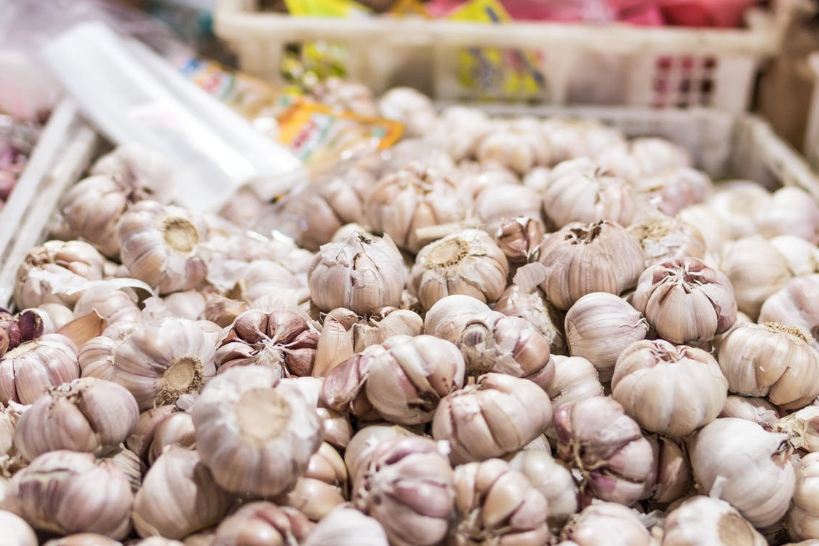Garlic is believed to be native to central Asia, South Asia or southwestern Siberia. There are also wild varieties native to Europe and North America.
Garlic has been in use for human consumption for at least 7000 years.
How much does garlic weigh?
| Garlic, Common | |||
|---|---|---|---|
| Clove | 2.8g | 0.1oz | |
| Head | 17 cloves/head (average) | 47.6g | 1.7oz |
| Cup | 136g | 4.8oz | |
| Teaspoon | 2.8g | 0.1oz | |
Everything You Need to Know about the Garlic
The garlic (Allium sativum) is an herb that belongs to the family Amaryllidaceae together with onion, chive, and shallot. It has been in use since ancient times both as food and a remedy for various illnesses. Interestingly, garlic is also associated with many mystical practices. Read on to learn everything about garlic and its common uses.
History
Garlic is one of the oldest cultivated crops in the world. Many scholars believe that this herb originated in Asia, particularly in its central and southern regions. Thanks to garlic fanatics, this strong-smelling herb reached Egypt, Pakistan, India, and China.
Since ancient times, garlic has served many purposes, such as food, medicine, magic potion, aphrodisiac, and even local currency. The Chinese and Japanese used this herb to treat diarrhea and digestion problems. It was also used for getting rid of intestinal worms and alleviating mood disorders such as depression. Meanwhile, the Indians treated heart disease and arthritis using garlic as described in the medical text “Charaka-Samhita.”
Perhaps, it was in ancient Egypt where garlic gained wide popularity to the extent of being worshipped as a god. The herb existed as early as the time when the building of the pyramids of Giza started. The laborers and slaves building the pyramids received garlic as payment. They consumed the nutritious herb to increase their stamina and protect themselves from various diseases. Garlic was so valuable that when the supply of garlic runs out, the workers also stop toiling.
In ancient Greece, garlic was used for cleansing and addressing pulmonary and abdominal problems. On the other hand, ancient Romans used garlic for gastrointestinal disorders, animal bites, and joint disease.
Another use of garlic in the classical world is for warding off evil spirits. Ancient people would hang knobs of garlic on their front doors to drive away evil, and some wear them as a necklace to protect themselves from harmful elements. As a food, only the lower classes the garlic because the elites refuse to eat the herb due to its pungent smell.
Garlic was brought back to Europe by Roman crusaders during the Medieval Period. There it was grown in monasteries and was studied for its therapeutic uses. European settlers then introduced the herb to America.
Where the Garlic is Grown
The garlic is grown in regions that have mild climates. As of 2017, the largest producers of garlic are China (20 million tonnes), India (1.25 million tonnes), South Korea (0.35 million tonnes), Egypt (0.26 million tonnes), and Russia (0.26 million tonnes). In the United States, garlic is mostly grown in Gilroy, California – the garlic capital that celebrates the garlic festival every summer.
Nutrition
Despite its small size, garlic is packed with vitamins and minerals such as vitamin B, vitamin C, calcium, manganese, selenium, phosphorus, iron, copper, and potassium. According to FoodData Central, a clove of raw garlic weighing three pounds contains the following:
- Manganese: 2% of the Daily Value (DV)
- Vitamin B6: 2% of the DV
- Vitamin C: 1% of the DV
- Selenium: 1% of the DV
- Fiber: 0.06 grams
Varieties
There are two classifications for garlic varieties. These are softneck (Allium sativum) and hardneck (Allium ophioscorodon).
The softneck variety has two types, namely artichoke and silverskin. Artichokes have a thick off-white layer that covers up to 20 cloves. Their shelf life could be as long as eight months. Some artichoke varieties include Applegate, California Early, California Late, Polish Red, Red Toch, Early Red Italian, Galiano, Italian Purple, Lorz Italian, Inchelium Red, and Italian Late.
On the other hand, silverskins are known for their ability to adapt to any climate. They are high-yielding and are commonly used for garlic braids. Their varieties include Polish White, Chet’s Italian Red, and Kettle River Giant.
The hardneck garlic variety is represented by the Rocambole, which has large cloves and a more intense flavor than the softnecks. Other hardnecks include Chesnok Red, German White, Polish Hardneck, Persian Star, Purple Stripe, and Porcelain.
Uses
Garlic is popularly used as a condiment. Fresh garlic, garlic powder, and garlic oil can boost the flavor of many foods and beverages.
Medicinally, garlic is used to treat ailments related to the heart and blood system. These ailments include high blood pressure, hyperlipidemia (high cholesterol levels), and atherosclerosis (hardening of the arteries).
